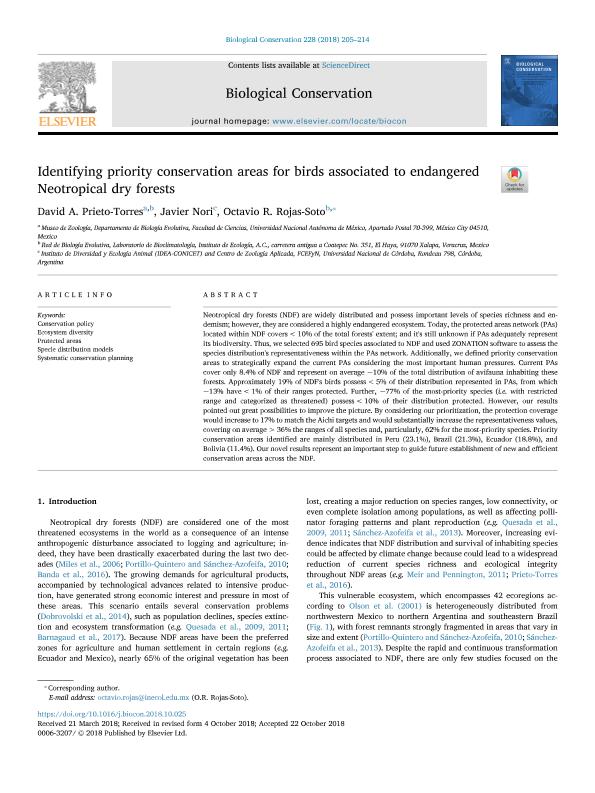Mostrar el registro sencillo del ítem
dc.contributor.author
Prieto Torres, David Alexander

dc.contributor.author
Nori, Javier

dc.contributor.author
Rojas Soto Octavio R
dc.date.available
2019-11-27T17:33:06Z
dc.date.issued
2018-12
dc.identifier.citation
Prieto Torres, David Alexander; Nori, Javier; Rojas Soto Octavio R; Identifying priority conservation areas for birds associated to endangered Neotropical dry forests; Elsevier; Biological Conservation; 228; 12-2018; 205-214
dc.identifier.issn
0006-3207
dc.identifier.uri
http://hdl.handle.net/11336/90662
dc.description.abstract
Neotropical dry forests (NDF) are widely distributed and possess important levels of species richness and endemism; however, they are considered a highly endangered ecosystem. Today, the protected areas network (PAs) located within NDF covers <10% of the total forests' extent; and it's still unknown if PAs adequately represent its biodiversity. Thus, we selected 695 bird species associated to NDF and used ZONATION software to assess the species distribution's representativeness within the PAs network. Additionally, we defined priority conservation areas to strategically expand the current PAs considering the most important human pressures. Current PAs cover only 8.4% of NDF and represent on average ~10% of the total distribution of avifauna inhabiting these forests. Approximately 19% of NDF's birds possess <5% of their distribution represented in PAs, from which ~13% have <1% of their ranges protected. Further, ~77% of the most-priority species (i.e. with restricted range and categorized as threatened) possess <10% of their distribution protected. However, our results pointed out great possibilities to improve the picture. By considering our prioritization, the protection coverage would increase to 17% to match the Aichi targets and would substantially increase the representativeness values, covering on average >36% the ranges of all species and, particularly, 62% for the most-priority species. Priority conservation areas identified are mainly distributed in Peru (23.1%), Brazil (21.3%), Ecuador (18.8%), and Bolivia (11.4%). Our novel results represent an important step to guide future establishment of new and efficient conservation areas across the NDF.
dc.format
application/pdf
dc.language.iso
eng
dc.publisher
Elsevier

dc.rights
info:eu-repo/semantics/openAccess
dc.rights.uri
https://creativecommons.org/licenses/by-nc-sa/2.5/ar/
dc.subject
CONSERVATION POLICY
dc.subject
ECOSYSTEM DIVERSITY
dc.subject
PROTECTED AREAS
dc.subject
SPECIE DISTRIBUTION MODELS
dc.subject
SYSTEMATIC CONSERVATION PLANNING
dc.subject.classification
Conservación de la Biodiversidad

dc.subject.classification
Ciencias Biológicas

dc.subject.classification
CIENCIAS NATURALES Y EXACTAS

dc.title
Identifying priority conservation areas for birds associated to endangered Neotropical dry forests
dc.type
info:eu-repo/semantics/article
dc.type
info:ar-repo/semantics/artículo
dc.type
info:eu-repo/semantics/publishedVersion
dc.date.updated
2019-10-16T14:28:26Z
dc.journal.volume
228
dc.journal.pagination
205-214
dc.journal.pais
Países Bajos

dc.journal.ciudad
Amsterdam
dc.description.fil
Fil: Prieto Torres, David Alexander. Instituto de Ecología. Laboratorio de Bioclimatología. Red de Biología Evolutiva; México. Universidad Nacional Autónoma. Facultad de Ciencias. Departamento de Biología Evolutiva. Museo de Zoología; México
dc.description.fil
Fil: Nori, Javier. Consejo Nacional de Investigaciones Científicas y Técnicas. Centro Científico Tecnológico Conicet - Córdoba. Instituto de Diversidad y Ecología Animal. Universidad Nacional de Córdoba. Facultad de Ciencias Exactas Físicas y Naturales. Instituto de Diversidad y Ecología Animal; Argentina
dc.description.fil
Fil: Rojas Soto Octavio R. Instituto de Ecología. Laboratorio de Bioclimatología. Red de Biología Evolutiva; México
dc.journal.title
Biological Conservation

dc.relation.alternativeid
info:eu-repo/semantics/altIdentifier/url/https://linkinghub.elsevier.com/retrieve/pii/S0006320718304075
dc.relation.alternativeid
info:eu-repo/semantics/altIdentifier/doi/http://dx.doi.org/10.1016/j.biocon.2018.10.025
Archivos asociados
